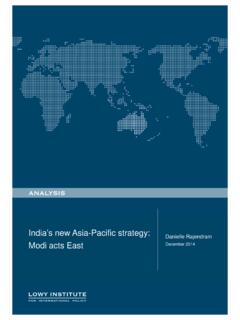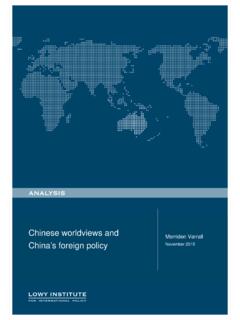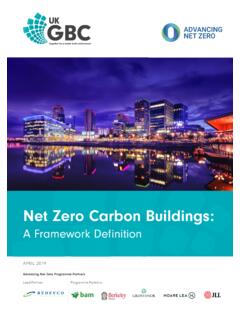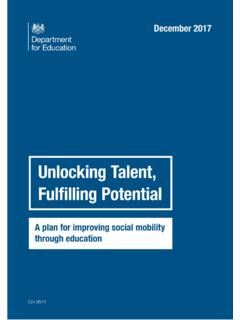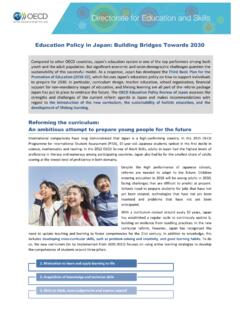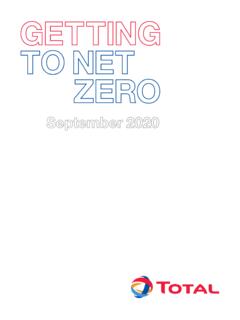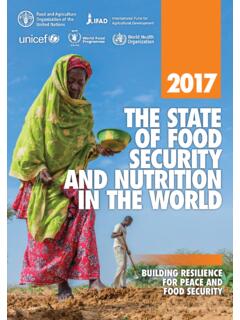Transcription of Understanding China’s Belt and Road Initiative
1 Understanding China s Belt and Road Initiative Peter Cai March 2017 Understanding CHINA S BELT AND ROAD Initiative The Lowy Institute for International Policy is an independent policy think tank. Its mandate ranges across all the dimensions of international policy debate in Australia economic, political and strategic and it is not limited to a particular geographic region. Its two core tasks are to: produce distinctive research and fresh policy options for Australia s international policy and to contribute to the wider international debate promote discussion of Australia s role in the world by providing an accessible and high-quality forum for discussion of Australian international relations through debates, seminars, lectures, dialogues and conferences.
2 Lowy Institute Analyses are short papers analysing recent international trends and events and their policy implications. The views expressed in this paper are entirely the author s own and not those of the Lowy Institute for International Policy. Understanding CHINA S BELT AND ROAD Initiative 1 EXECUTIVE SUMMARY China s Belt and Road Initiative (also known as One Belt, One Road (OBOR)) is one of President Xi s most ambitious foreign and economic policies. It aims to strengthen Beijing s economic leadership through a vast program of infrastructure building throughout China s neighbouring regions.
3 Many foreign policy analysts view this Initiative largely through a geopolitical lens, seeing it as Beijing s attempt to gain political leverage over its neighbours. There is no doubt that is part of Beijing s strategic calculation. However, this Analysis argues that some of the key drivers behind OBOR are largely motivated by China s pressing economic concerns. One of the overriding objectives of OBOR is to address China s deepening regional disparity as the country s economy modernises. Beijing hopes its transnational infrastructure building program will spur growth in China s underdeveloped hinterland and rustbelt.
4 The Initiative will have a heavy domestic focus. The Chinese Government also wants to use OBOR as a platform to address the country s chronic excess capacity. It is more about migrating surplus factories than dumping excess products. One of the least understood aspects of OBOR is Beijing s desire to use this Initiative to export China s technological and engineering standards. Chinese policymakers see it as crucial to upgrading the country s industry. Understanding CHINA S BELT AND ROAD Initiative 2 INTRODUCTION At the end of 2013 Chinese President Xi Jinping announced one of China s most ambitious foreign policy and economic initiatives.
5 He called for the building of a Silk Road Economic Belt and a 21st Century Maritime Silk Road, collectively referred to as One Belt, One Road (OBOR) but which has also come to be known as the Belt and Road Initiative . Xi s vision is an ambitious program of infrastructure building to connect China s less-developed border regions with neighbouring countries. OBOR is arguably one of the largest development plans in modern history. On land, Beijing aims to connect the country s underdeveloped hinterland to Europe through Central Asia. This route has been dubbed the Silk Road Economic Belt.
6 The second leg of Xi s plan is to build a 21st Century Maritime Silk Road connecting the fast-growing Southeast Asian region to China s southern provinces through ports and railways. Understanding CHINA S BELT AND ROAD Initiative 3 All levels of the Chinese Government, from the national economic planning agency to provincial universities, are scrambling to get involved in OBOR. Nearly every province in China has developed its own OBOR plan to complement the national blueprint. Major state-owned policy and commercial banks have announced generous funding plans to fulfil President Xi s ambitious vision.
7 Xi has launched OBOR at a time when Chinese foreign policy has become more This has meant that OBOR is often interpreted as a geopolitical plan rather than a purely economic one. While there is a great deal of truth to this interpretation, this Analysis argues that focusing on the geopolitical dimensions of OBOR obscures its principally geoeconomic drivers, in particular its connection to changes in China s domestic industrial policy. OBOR: GEOSTRATEGY OR GEOECONOMICS? Before the 18th Party Congress in 2013, there were heated debates among Chinese policymakers and scholars about the strategic direction of the country s foreign policy,2 especially in its In October 2013 Beijing convened an important work conference on what it termed peripheral diplomacy.
8 It was reportedly the first major foreign policy meeting since 2006 and the first-ever meeting on policy towards neighbouring countries since the founding of the People s Republic. It was attended by all of the most important players in the Chinese foreign policymaking process, including the entire Standing Committee of the At the Peripheral Diplomacy Work Conference, Xi said that China s neighbours had extremely significant strategic value . He also said that he wanted to improve relations between China and its neighbours, strengthening economic ties and deepening security Maintaining stability in China s neighbourhood is the key objective of peripheral diplomacy.
9 We must encourage and participate in the process of regional economic integration, speed up the process of building up infrastructure and connectivity. We must build the Silk Road Economic Belt and 21st Century Maritime Silk Road, creating a new regional economic order. 6 Xi clearly sees China s considerable economic resources as a key tool in his efforts to maintain regional stability and assert China s leadership in the country s neighbourhood. Analysts regard the work conference as a significant turning point in the evolution of China s foreign policy. Douglas Paal of the Carnegie Endowment for International Peace argues that the conference saw the Chinese leadership effectively bury former leader Deng Xiaoping s famous dictum, hide your strength and bide your time.
10 According to Paal, in its place, the new Chinese We must encourage and participate in the process of regional economic integration, speed up the process of building up infrastructure and connectivity. Understanding CHINA S BELT AND ROAD Initiative 4 leadership have advanced a more proactive diplomacy in surrounding This new more activist foreign policy has reinforced the impression that OBOR is primarily driven by broad geostrategic aims. Certainly some elements of OBOR are consistent with such a characterisation. The China Pakistan Economic Corridor is a prime example.

